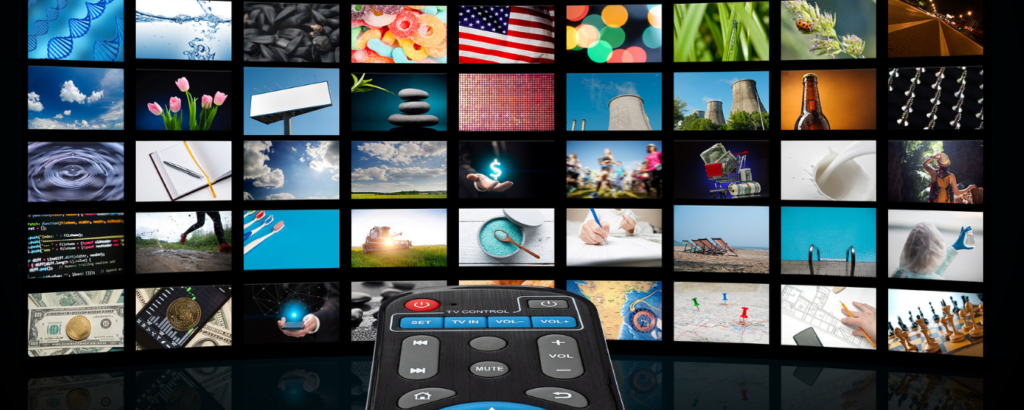

Provocateur:
What hasn’t the pandemic changed? I’m scratching my head, but I can’t come up with anything. Hiking, maybe? Not that I hike much, but I’m just trying to think of something Covid-19 hasn’t changed in some way. Even our presidential election was altered by the virus—with a majority of voters sending their ballots by mail.
The real sea change since we found ourselves in the grip of Covid-19, back in mid-March, has been how much time we are all spending online—and what we’re doing online. We’re all shopping online a lot more, of course; but, with more time at home and on a variety of devices, we’re also consuming a lot more media online, whether it’s films, eBooks, music, news, or podcasts. Even if you aren’t spending more time on Netflix or Spotify, you’re probably still using Zoom for work, and maybe Messenger for video calls with family and friends.
Like you, I’ve been on the Internet more than I was before spring. While surfing, I came across Visual Capitalist, a company that creates fascinating infographics, and I found a collection I think might be especially useful for digital marketers: How Total Spend by U.S. Advertisers Has Changed, Over 20 Years. Of course, the COVID-19 pandemic has resulted in a major upheaval of advertising spend, and it’s unlikely to recover for a while. This means your best bet is to use your ad spend wisely by targeting your messaging to specific age groups.
In case you need it, here’s a quick breakdown of each generation within the 16-to-64 demographic:
- Baby boomers: born between 1944 and 1964 (vinyl)
- Generation X: born between 1965 and 1980 (cassette)
- Millennials: born between 1981 and 1996 (CD)
- Generation Z: born between 1997 and 2006 (streaming)
OK, now that we’re up to speed, here are some of the key takeaways from these terrific and incredibly informative infographics:
- More than half of Gen Z Internet users surveyed said they are watching far more videos online than they were prior to the pandemic; they are also playing more online video games.
- Millennial Internet users, who grew up in the age of blockbuster films and cable television, have increased their consumption of films and television programs. Millennials are also making more than half of their purchases online and will most likely continue to do so even after the pandemic dies down.
- Gen X, which grew up with network television, is now watching more television, both broadcast and online. My feeling is that this generation, which was reared with network news filling their living rooms mornings and evenings, feels compelled to keep up with the news during a turbulent time and is used to consuming it via television, mostly from CNN, MSNBC, etc.
- Boomers’ online habits have changed the least. They are still watching the most broadcast TV, with a bit of binge-watching on Netflix and Amazon, as well as on-demand video via their cable networks (which they are holding onto tightly, by the way—unless they’re borrowing a streaming subscription from their kids). These TV die-hards are used to settling into a comfy chair by the television, I guess (and I count myself among them!).
As you might imagine, everyone is checking online for COVID-19 updates, as the number of cases has started spiking again and vaccines have begun shipping. But as worried as we are about the coronavirus, we’re also worried about how much time we’re spending on our screens.
How can you as a marketer capitalize on these changes? A great place to start is to develop a relationship between your brand and a social media influencer, particularly if you’re marketing to the under-35 crowd. According to a recent article on Entrepreneur NEXT, an influencer is already using and enthusiastic about your products/services, casts a wide social media net that includes your target audience/consumer demographics, and is capable of creating conversations about purchasing choices with consumers.
There is an excellent example of this trend playing out in the sports world; specifically, boxing. In 2018, the year HBO (purveyor of the iconic “World Championship Boxing” and “Boxing After Dark” series) chose to cancel its boxing programming, Britain’s Top YouTuber, KSI, challenged his American counterparts, the Paul Brothers (Jake and Logan), to a boxing match to settle their differences. The influencer match-up, which streamed live as a pay-per-view event on YouTube, attracted more than 2 million viewers and secured more than 20 million views by the following day—many of which were younger-generation fans of the influencers, not boxing fans.
Fast forward to today, more non-boxers with younger fan bases are jumping into the ring. So much so that online and app-based outlets such as DAZN, IMPACT Boxing, and the Bare Knuckle Fighting Championship (BKFC) are bringing on additional younger personalities and influencers such as my son Zach Hirsch, hailed as the youngest ringside reporter in the world, to increase their Gen Z fan base.
Instagram and YouTube have been the dominant apps for influencers for some time, but if you’re looking to expand your marketing reach you might want to head on over to Snapchat and TikTok (which might not get banned after all), particularly if you’re pursuing Gen Z and millennial customers. According to Snapchat, on average, 249 million people use the app every day; it reaches 75 percent of millennial and Gen Z Internet users, who spend, on average, more than 30 minutes per day on the app. Forty-one percent of TikTok users are between 16 and 24 years old, and about 50 percent of its global audience is younger than 34, with 26 percent between 18 and 24.
Targeting Gen X and boomers? Look to Facebook and Amazon. And if you’re reading this, you’re probably already there. Gen X and boomers are using Facebook to connect with other fans of ‘70s and ‘80s bands, for example, to buy used bikes and vintage surfboards, and to share photos of kids and grandkids and Christmas cookies. As for their online purchases, they’re shopping on Amazon for everything from non-stick skillets to sci-fi movies. Though, like everyone else, they find a lot of video content on YouTube, I expect Facebook to remain their social media channel of choice for the foreseeable future, and I don’t expect them to migrate to any of the “younger” apps anytime soon. Whatever you’re doing on Facebook, keep it up.
This is all good news for digital marketers, as Katie Jones of Visual Capitalism stated earlier this year: “Regardless of what type of content we are consuming, the fact is that every generation is relying on their devices during this pandemic to inform and distract more than ever before, creating a huge opportunity for media companies to engage a captive audience.”
Here’s to capitalizing on this huge opportunity.
About the Author

Scott Hirsch, CEO of Media Direct, is an internationally recognized expert in data, analytics, and digital marketing. Hirsch has been published in Fortune, Time, INC., Forbes, Huffington Post, Entrepreneur, and Fox Business. He has helped pioneer some of the most utilized data technology concepts commonly used today, including opt-in email, e-appending, digital data/media marketing (SEO, Google Ads, and social media management), affiliate marketing, and DIY application development.








